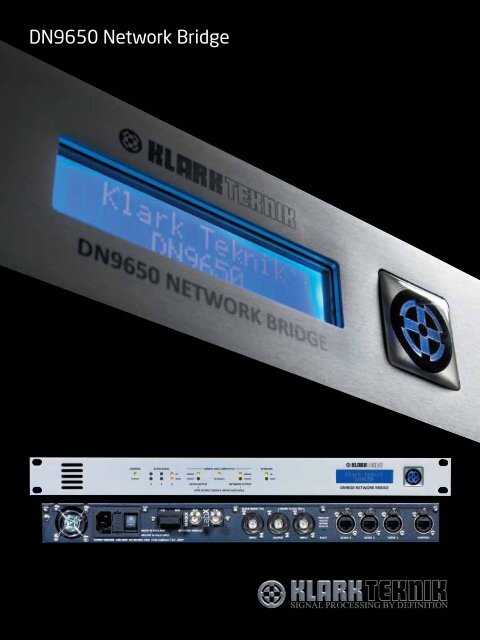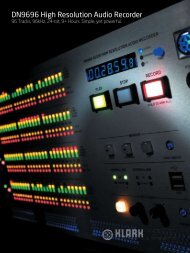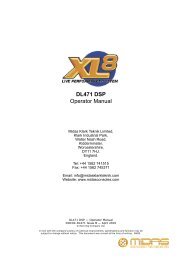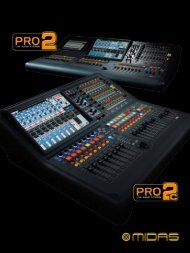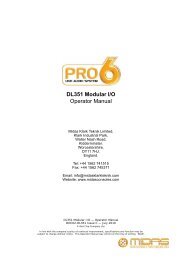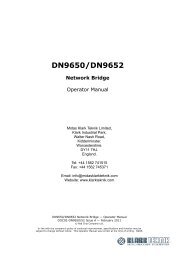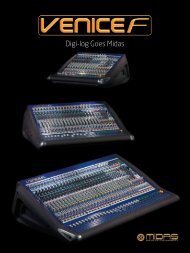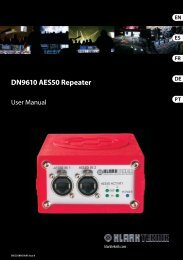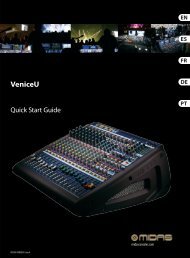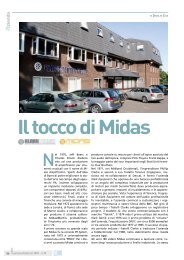DN9650 Network Bridge - Midas
DN9650 Network Bridge - Midas
DN9650 Network Bridge - Midas
Create successful ePaper yourself
Turn your PDF publications into a flip-book with our unique Google optimized e-Paper software.
<strong>DN9650</strong> <strong>Network</strong> <strong>Bridge</strong>
Architect’s & Engineer’s Specification<br />
The <strong>Network</strong> <strong>Bridge</strong> shall provide bidirectional asynchronous<br />
sample rate conversion of up to seventy-two (72)<br />
simultaneous channels of 24-bit resolution digital audio,<br />
between a three (3) port AES50 digital audio interface and a<br />
third party network module interface in a standard 1U high<br />
19” rack mount chassis.<br />
The <strong>Network</strong> <strong>Bridge</strong> shall have one (1) Ethernet Control Port<br />
for the purposes of remote configuration from a computer<br />
web browser interface and the updating of internal software.<br />
The <strong>Network</strong> <strong>Bridge</strong> shall have two clock domains (AES50<br />
and <strong>Network</strong>), separated by an Asynchronous Sample Rate<br />
Converter (ASRC). The Asynchronous Sample Rate Converter<br />
shall have a Bypass option with the facility to lock the<br />
<strong>Network</strong> Clock domain to the AES50 Clock domain.<br />
The AES50 Clock domain shall support selection of clock<br />
source from either internal (on-board clock oscillator) or<br />
external (incoming clock via AES50 ports) synchronisation,<br />
Word Clock input, or Video Black Burst input which shall<br />
support incoming video synchronisation signals in PAL/<br />
SECAM/NTSC formats in Standard Definition (SD) and High<br />
Definition (HD) resolutions.<br />
The <strong>Network</strong> Clock domain shall support clock<br />
synchronisation to incoming clock via third party network<br />
module, Word Clock Input or Video Black Burst Input which<br />
shall support incoming video synchronisation signals in PAL/<br />
SECAM/NTSC formats in Standard Definition (SD) and High<br />
Definition (HD) resolutions, as well as optionally slaving to<br />
the AES50 clock domain if the Sample Rate Converter is<br />
bypassed.<br />
The Word Clock Output shall be capable of being derived<br />
from the AES50 Clock Domain, the <strong>Network</strong> Clock domain or<br />
the Word Clock Input.<br />
The Dual <strong>Network</strong> <strong>Bridge</strong> shall have a precision clock<br />
reference provided by a temperature-controlled crystal<br />
oscillator (TCXO) with 1 part-per-million (1 ppm) stability.<br />
The <strong>Network</strong> <strong>Bridge</strong> shall have user-selectable functions<br />
for both the AES50 and <strong>Network</strong> Clock domains to stop<br />
an output clock if the corresponding input clock fails, to<br />
propagate network failures across the ASRC for the purposes<br />
of automatic or manual redundancy switchover.<br />
The <strong>Network</strong> <strong>Bridge</strong> shall support data format word length<br />
truncation and dithering on data received via the AES50<br />
ports and transmitted via the third party network module<br />
interface.<br />
The <strong>Network</strong> <strong>Bridge</strong> shall be capable of operating from a 100<br />
to 240V ±10%, 50 to 60Hz AC power source.<br />
The <strong>Network</strong> <strong>Bridge</strong> shall be the Klark Teknik <strong>DN9650</strong> and no<br />
alternative option is available.<br />
There are many different multichannel digital audio protocols available today. Some are well established and have<br />
been in common use for several years, others have appeared recently, and all are vying for recognition and market<br />
share. Interfacing different protocols can be difficult and expensive, often requiring the use of inflexible, proprietary<br />
hardware. Connecting different audio networks together, which often have differing sample rates and clock domains<br />
can be a difficult and expensive process. The <strong>DN9650</strong> <strong>Network</strong> <strong>Bridge</strong> allows all <strong>Midas</strong> digital consoles and <strong>Midas</strong><br />
digital I/O hardware, Klark Teknik DN9696 High Resolution Audio Recorders and many other AES50 devices to connect<br />
to many different multichannel digital audio networks simply and reliably.<br />
Currently available interfaces include:-<br />
• Audinate Dante<br />
• Aviom A-Net<br />
• Cirrus Logic CobraNet<br />
• Digigram EtherSound<br />
• MADI (AES10)<br />
The <strong>DN9650</strong> <strong>Network</strong> <strong>Bridge</strong> supports network modules designed and manufactured by Cirrus Logic, Inc., Lab X<br />
Technologies, LLC, and Audinate Pty Ltd.<br />
<strong>DN9650</strong> <strong>Network</strong> <strong>Bridge</strong> features include:-<br />
• Three AES50 ports each supporting 24 bi-directional channels of 24-bit 96kHz audio (72 bi-directional channels in total)<br />
• 1:1 channel mapping between AES50 channels and <strong>Network</strong> Module interfaces<br />
• Bidirectional Asynchronous Sample Rate Conversion (ASRC) on every channel with Bypass facility<br />
• User-selectable bidirectional “Stop Output Clock if Input Clock fails” function, to propagate network failures across<br />
ASRC for automatic or manual redundancy switchover<br />
• Data format word length truncation and dithering<br />
• Ultra-high stability reference-grade 1 part-per-million (1 ppm) temperature-controlled clock oscillator<br />
• Supports operation at 44.1 kHz, 48 kHz and 96 kHz sampling frequencies<br />
• Flexible third party interface clock synchronisation options:-<br />
<strong>Network</strong> Module Incoming and Outgoing Clocks<br />
<strong>Network</strong> Module Onboard Clock (with or without Word Clock In synchronisation)<br />
Word Clock Input<br />
Word Clock Output<br />
Video Black Burst In (PAL/SECAM/NTSC formats in Standard Definition (SD) and High Definition (HD) resolutions)<br />
• Platform-independent web browser configuration interface software hosted on integrated Linux web server<br />
• Ethernet Control port for remote computer connection (web browser configuration and software updating)<br />
• 100V-240V universal power supply<br />
• 1U High 19” rackmount<br />
Clock Synchronisation<br />
The <strong>DN9650</strong> clock synchronisation scheme is divided into two domains, with the AES50 domain and third party<br />
network domain separated by the Asynchronous Sample Rate Converter (ASRC).<br />
AES50 Domain Clock Options:-<br />
• AES50 External Clock<br />
• Onboard Oscillator (AES50 Internal Clock)<br />
• Word Clock Input<br />
• Video Black Burst Input<br />
<strong>Network</strong> Domain Clock Options:-<br />
• External <strong>Network</strong> Clock<br />
• External <strong>Network</strong> Clock with Word Clock In Synchronisation<br />
• Onboard Oscillator (AES50 Internal Clock)<br />
• <strong>Network</strong> Module Onboard Clock<br />
• AES50 Clock Source<br />
• Word Clock Input<br />
• Video Black Burst Input<br />
Note: Selection from above options may be limited by feature set of Third Party Module fitted.<br />
Front panel description<br />
• 1 x Inlet Air Vent<br />
• 1 x ETHERNET CONTROL Activity LED (Green)<br />
• 3 x Pairs of green and red AES50 status LED indicators<br />
(OK, ERROR)<br />
• 2 x AES50 Output “STOP OUTPUT CLOCK IF INPUT FAILS”<br />
yellow and red LED indicators (ENABLED, STOPPED)<br />
• 1 x Asynchronous Sample Rate Converter ASRC<br />
ENABLED LED indicator<br />
• 2 x <strong>Network</strong> Output “STOP OUTPUT CLOCK IF INPUT<br />
FAILS” yellow and red LED indicators<br />
(ENABLED, STOPPED)<br />
• 1 x Pair of green/red <strong>Network</strong> Clock Status LED<br />
indicators (OK, ERROR)<br />
• 1 x Backlit Alphanumeric LCD Display (16 characters x<br />
2 Lines)<br />
• 1 x Klark Teknik Tufflex label roundel label with Blue<br />
LED illumination<br />
Rear panel description<br />
• 1 x Ethernet Control Port - Neutrik EtherCon with LED<br />
status indication<br />
• 3 x AES50 Ports – Neutrik EtherCons with LED<br />
status indication<br />
• 1 x Reset Switch (recessed)<br />
• 1 x Word Clock Input – Neutrik BNC<br />
with 75 ohm termination<br />
• 1 x Word Clock Output – Neutrik BNC (no termination)<br />
• 1 x Video Black Burst Input – Neutrik BNC<br />
with 75 ohm termination<br />
• 1 x <strong>Network</strong> Module<br />
• 1 x mains inlet with integral fuseholder and switch<br />
• 1 x 40 mm fan outlet with finger guard<br />
• Electrical Safety Earthing Point<br />
Power Requirements<br />
Voltage 100V a.c. to 240V a.c. ±10%<br />
Frequency 50Hz to 60Hz<br />
Consumption


